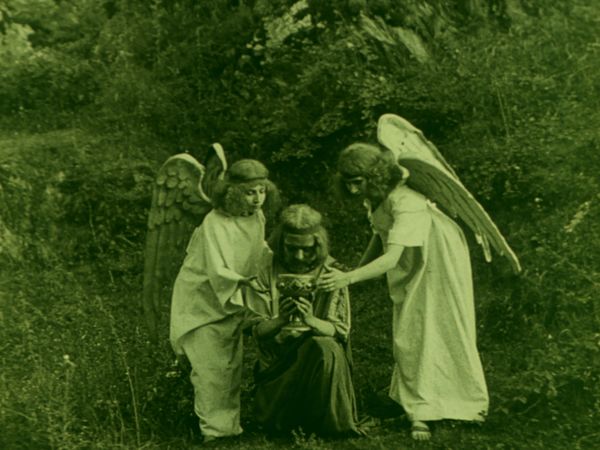PARSIFAL
(Parzival)
Mario Caserini (IT 1912)
At the beginning of his collaboration with the Ambrosio production company, which lasted just over a year, Mario Caserini (1874-1920) directed Wagner’s famous drama Parsifal, “a complete re-enactment of the purest of Germanic heroes” (La Fotografia Artistica, no. 9, September 1912). The screenplay was entrusted to Arrigo Frusta (1875-1965), who had joined Ambrosio in 1908 as a writer with a marked interest in costume subjects. This “sacred drama par excellence”, as Wagner defined it, revolves around the custody of the Holy Grail.
After King Amfortas (Mario Bonnard) – fallen into sin and corrupted by Satan’s servants, the wizard Klingsor and the witch Kundry (Mary Cléo Tarlarini) – fails to protect the sacred relic, Parsifal is named as its protector. Fired by hatred of the Grail, the two agents of evil do their utmost to tempt the young man into sin, resorting to the most extreme methods, but fail. Devoutly committed to the path of righteousness, Parsifal learns the secrets of the Grail from the Bishop.
The work’s celebrated plot, laden with meaning, is well rendered by Caserini’s screen adaptation. In La Vita Cinematografica (no. 21, 25 November 1912) “Il rondone” described a “magnificent mise-en-scène; everything is reproduced with meticulous accuracy: weapons, props, costumes, etc. Technically impeccable and beautifully photographed”.
The publicity surrounding the film’s release emphasized its use of “period costumes supplied by Milan’s La Scala” and over “500 extras”. A number of elements confirm the film’s scale: the use of spatial depth, with the diagonal movement of the actors across the scene, exaggerates the size of the sets, just as the camera’s off-centre position creates a sense of action taking place on different planes. The numerous outdoor scenes set in woodland or on the banks of streams emphasize the sense of mysticism that permeates the story; they are balanced by the inevitable interior scenes, like those in the church and the castle, expected in the plot. Into this balancing act Caserini inserts intriguing “special effects”, such as the memorable scene in which the servants see Parsifal’s arrival from a hilltop via the reflection of a circular mirror, and then are suddenly transformed into high-born nobles; or, the one in a forest, where an army of hundreds of soldiers suddenly appears before Parsifal. Special mention should go to the dance of the ghosts, who emerge from the flames of a fire, summoned by Klingsor and Kundry, and set out for Parsifal to challenge him to a swordfight.
Mario Bonnard, then 22 years old, already had about ten films behind him when he joined Ambrosio in January 1912. Though the contemporary reviews of Parsifal concentrated on the better-known Tarlarini (as Kundry) and Maria Caserini Gasparini (as Parsifal’s mother), Bonnard fits the role of the naïve young Amfortas perfectly. His acting, at some points still uncertain, is however especially believable in the scene of amorous entrapment – with a kiss that reveals the poses of the future divo – and in his tortured repentance for the sin he has committed. Bonnard was still a long way from the characteristic roles of an amorous companion to young ladies which were to bring him fame and celebrity little more than a year or so later, but this apprenticeship with Caserini, with whom more films followed, and in a big company like Ambrosio, was destined to bear some interesting fruit.
Marcello Seregni

regia/dir: Mario Caserini.
sogg/story: Alberto A. Capozzi.
scen, adapt: Arrigo Frusta, dal libretto di/from the opera libretto by Richard Wagner (1882).
photog: Angelo Scalenghe.
cast: Vitale De Stefano (Parsifal), Mario Bonnard (Amfortas), Mary Cléo Tarlarini (la maga Kondrie/the witch Kundry), Maria Caserini Gasparini (la madre di Parsifal/Parsifal’s mother), Antonio Grisanti (il vescovo/The Bishop), Dario Silvestri, Oreste Grandi, Filippo Costamagna, Serafino Vité, Lia Negro, Cesare Zocchi, Mario Voller Buzzi.
prod: Ambrosio (film n. 731).
uscita/rel: 22.11.1912.
v.c./censor date: 22.06.1915 (n. 9544).
copia/copy: 35mm, 1029 m. (orig. 1064 m.), 50′ (18 fps), col. (imbibito/tinted); did./titles: NLD.
fonte/source: EYE Filmmuseum, Amsterdam.
Preservazione: 1990, laboratorio Haghefilm, da un internegativo./Preserved 1990 at Haghefilm via internegative.


 Italiano
Italiano